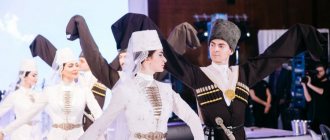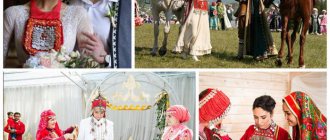A Dagestan wedding is a beautiful celebration that is celebrated for several days on a grand scale. The holiday is accompanied by national customs and traditions that are unlike those of other nations.
To attend a Dagestan wedding means to see the entire culture of the people. After all, at a wedding they not only observe customs, but also make national toasts, dance Dagestan dances, and put on folk costumes.
What is it like - a beautiful Dagestan wedding?
Features of the national celebration
Dagestan weddings are difficult to confuse with any others. And all thanks to national characteristics.
- A traditional Dagestan wedding is celebrated for two days. But exactly 7 more days pass between them.
- There are a huge number of guests at the wedding - from 300 to 1500. These are necessarily close and distant relatives, friends, colleagues. People who are not officially invited can also come to the celebration: neighbors, acquaintances, or simply residents of a city or village. The last ones do not have to stay at the holiday, but they are obliged to congratulate the newlyweds and make a toast.
- At the request of the parents and newlyweds, the wedding can be held in one of two options: a religious Muslim one without alcohol, loud music and dancing, or a classic one with alcohol, a lush table, and noisy festivities.
- Parents begin collecting money for a wedding from the birth of their child. Guests give a lot of money for the future wedding, for the bride's dowry, for ransom. This fact leads to the fact that money for organizing a wedding goes without an account.
- A national feature, which is now rarely observed, was that the parents themselves chose the groom for the bride. The newlyweds got to know each other right at the wedding. Nowadays this custom is observed extremely rarely.
- In the past, bride kidnapping was a very common practice. It was a beautiful national custom. Now they resort to it when the parents of the bride and groom do not give their blessing for the marriage. When the groom steals his beloved, he brings her to his house. And an unmarried girl who spends the night in a man’s house is considered disgraced. And, in order to wash away this shame from the family, the parents have no choice but to agree to the wedding.
- The wedding date should not fall on the newlyweds' birthdays, parents' birthdays, or Muslim religious holidays.
Acquaintance and conspiracy
In the old days, it was customary to persuade children from the cradle. And this is not a whim: with the restrictions that wedding traditions imposed, it was quite difficult to find a suitable couple in the region. Basically, this custom flourished among wealthy families. The father of the young groom gave a valuable thing as collateral, and the children were considered to be in agreement.
The most common was collusion between boys and girls in adolescence and adulthood. Senior relatives and parents were looking for the bride, including all their friends and neighbors. The girl had to demonstrate certain qualities: hard work, restraint of emotions, knowledge of etiquette. Physical health, the absence of deformities and mental illness among relatives, the origin and well-being of the family were also important. Before the wedding, the young couple may not have known each other at all.
In modern Dagestan, young people have the opportunity to make acquaintances on their own. But even now, boys and girls listen to the opinions of older relatives, and marriage without the blessing of their parents is unthinkable.
Another traditional way to get married was bride kidnapping. This move made it possible to avoid the huge costs of ransom and wedding arrangements, as well as to marry against the will of the chosen girl’s relatives. As a rule, refusal followed if the applicant for the daughter’s hand in marriage was lower on the social ladder, from an impoverished family, or from a family with which there was enmity. A girl who spent the night under the roof of a stranger was considered disgraced. If she managed to escape before dawn, then it was believed that the girl managed to defend her honor. If not, the relatives had no choice but to agree to an immediate wedding. However, enraged relatives could declare blood feud for the shame of their daughter and sister, which did not ease the fate of the unfortunate woman, who was losing hope of a worthy match. Bride kidnapping these days is prosecuted by law, and usually occurs by mutual consent, as a beautiful, stylized antique ritual.
How does matchmaking work?
The customs of a Dagestan wedding begin with matchmaking. It is also called collusion. This is the procedure for concluding an agreement and discussing all the nuances. Representatives of the groom: parents, relatives, friends come to the house of the future wife, look at the well-being of the family, inquire about the bride's dowry, and discuss the size of the bride price. There is no fixed size in this matter.
Matchmaking can be carried out in two ways:
- The agreement between the parents is concluded when the bride and groom are still children. Such a conspiracy is called a “lullaby”. During this ceremony, the opinions and wishes of the bride and groom are not asked. If all the conventions were discussed, the father of the bride gave the father of the groom a valuable thing, which served as a symbol of the conclusion of the contract, and from now on the children became the bride and groom. More often such collusion can be found among the Lezgins.
- The conspiracy takes place when the potential bride and groom are already adults. This look is relevant for a modern Dagestan wedding. The bride is given valuable gifts, which in some regions, along with her dowry, are hung on ropes near the house, showing them off to others. If everyone is satisfied with everything, then the engagement takes place. Afterwards, the groom and parents visit the bride's house, and then a return visit is held.
Food
The food was extremely varied. The main products that were used for cooking were agricultural and livestock products - wheat, barley and corn flour, various cereals, rice, beans, flax, meat, milk, butter, poultry, garden crops: onions, garlic, pumpkin, watermelons, melons, cucumbers, garden crops: apples, pears, grapes, apricots. Starting from the second half of the 19th century, new foods began to be consumed: potatoes, cabbage, tomatoes, tea, sugar, and various sweets. As before, the mountaineers did not eat pork and rarely ate fish, although the waters of Dagestan abounded in it.
Kitchen utensils changed: along with wooden and pottery utensils (in peasant families), wealthy people began to use imported porcelain, earthenware, glass and other utensils, high tables and chairs.
The meat was consumed fresh and dried. But the daily food of most residents of Dagestan was various porridges and soups, pies filled with herbs and cottage cheese, khinkal with sour cream, curdled milk, cheese, and garlic. As a rule, in the mountain sakla they limited themselves to one of the listed dishes. But in wealthy families, dishes were divided into first, second, third: soups, broths, Lezgin khinkal with meat, pilaf, shish kebab, scrambled eggs, pies and meat miracles, halva, jam, fruit, honey, tea with sugar. However, the main food of the vast majority of mountaineer peasants was wheat, corn or barley churek, a piece of cheese and sour milk.
The variety of food of the mountaineers in the period under review and their clothing was greatly influenced by otkhodnichestvo, which became widespread from the end of the 19th century.
Wedding preparations
You can celebrate the occasion in the restaurant hall, banquet hall, or at home. The main thing is that the room is spacious enough, since the number of guests varies from several hundred to two thousand. Such a scale involves spending huge sums of money.
They start collecting money from the birth of children, but the actual preparation for the celebration begins after the engagement. Both the bride and the groom begin to prepare. The first day of the holiday is spent with the bride, the second - with the groom. If living conditions do not allow hosting a huge number of guests, then it is possible to hold the event in a restaurant.
Official registration takes place only on the second day. By the way, extending the wedding over two days is associated with national custom: parents do not have the right to attend such an event with their daughter, since she came under the protection of the groom’s family. The bride went to the groom's house accompanied by her unmarried sisters.
But the parents wanted to see their daughter’s wedding, and the bride herself wanted her parents not to stay away from the important day in her life. In order not to offend anyone, but also not to go against custom, mini-weddings began to be held in the bride’s house. In modern Dagestan, gatherings in the bride's house have become a full-fledged wedding day, which is celebrated on a grand scale.
After the engagement, the preparations are mainly carried out by the parents of the newlyweds. But the bride also does not stand aside. Her responsibilities include preparing the future family “nest”: choosing furniture, arranging it in the house, and decorating the interior.
Ancestral spirits
“LegukIetyn” is a silk fabric, a path that is used to line the path of the bride who has just arrived at the groom’s house. When a girl walks along it, she is showered with cereals, candies, money, “programming” so that the young people will have wealth in the house. She is carried into the room through the threshold. This is a must, no matter how ultra-modern the wedding is. There is a superstition that if a girl stops on the threshold or steps over it herself, the young people will live unhappily. The thing is that, according to old beliefs, the souls of ancestors live under the threshold, which cannot be disturbed, even by accident.
The girl is taken to a room specially reserved for her, after which numerous relatives of the guy enter. They shower the bride with sweets and money - this gives them the right to look at her by lifting her cape.
Dresses for the celebration
In a modern Dagestan wedding, brides are not limited in their choice of dress. The only condition is that it must be long, graceful, expensive and sophisticated: made from expensive fabrics with the addition of expensive jewelry. No scarf or veil is used.
However, no one forgets about the traditional decoration of the bride. It is being prepared as a second outfit for a wedding.
For the groom, everything is much simpler with his outfit - any classic suit. But if you do not deviate from traditions, then the groom must have a second wedding suit in which he will perform a formal dance. The main attribute of this costume is the hat.
Agultsy
The Agul people of Dagestan live in its southern part. The size of this population is approximately 8-9 thousand people. To communicate, they use the Agul language, which is related to Lezgin. This nation lives in 21 settlements in southeastern Dagestan.
The traditions of this people, like the traditions of the peoples of Dagestan in general, are unique. For centuries, the main occupation for the Agul people was cattle breeding. Only men had the right to care for sheep. Women worked exclusively with cattle.
Metal processing was a very important aspect of the life of the Agul people. Blacksmiths made axes, scythes, knives and sickles, which were useful in any household. The Agul people were excellent builders. They built bridges, houses and mosques. They decorated their buildings with skillfully carved stones, the ornaments of which reflected the entire culture of the peoples of Dagestan.
Wedding: day one
Holding the holiday over two days is also explained by the fact that, as a rule, a Dagestan wedding is celebrated only once. Divorce is an extremely rare phenomenon among the Dagestan people. The strength of the union is connected with the religiosity of the people.
The first day of the wedding - in the bride's house - begins with the performance of ritual music. Invited musicians sit on the roof of the bride's house and perform folk songs reminiscent of a prayer motif.
At this time, the bride is actively preparing for a Dagestan wedding in the house. At 12 o'clock in the afternoon, a festive procession leaves the groom's house, consisting only of women - the groom's relatives. The groom himself and his entourage follow the procession, performing songs characteristic of a Dagestan wedding. Those walking with them carry gifts in the form of sweets, jewelry and carpets. As soon as the guests enter the bride’s house, all the brought treats and gifts are put into a chest, which the bride will take with her to her now home.
The bride's mother, accompanied by other female relatives, hands over her daughter to the groom's family. The whole process is accompanied by crying and lamentations, which are used to mourn the daughter’s departure from her parents’ home. Although that night the bride still remains in her parents' house.
Laktsy
The central part of Nagorno-Dagestan is inhabited by another people - the Laks. Language – Lak, religion – Islam. This people have lived on the territory of Dagestan since ancient times. Their main occupation is growing wheat crops (rye, wheat, millet, legumes, barley, etc.). Livestock farming was also developed. Among the crafts, cloth making, jewelry making, pottery, stone processing, silver and gold embroidery were developed. The Laks were famous traders, confectioners and acrobats. This people is rich and epic. Stories about the great heroes of the past and how they fought evil were passed down from mouth to mouth.
Wedding: day two
The second day takes place at the groom's house. He comes to his wife's house and takes her under his wing. But before picking up the bride, the groom is greeted by her sister, performing a national celebratory dance before the wedding. Afterwards, the girl’s mother gives the newlyweds a cup of honey to drink. This is a symbol of a happy family life.
It is on the second day that many noisy and fun events take place. Shooting in the air, songs and dances, competitions for guests. On the second day of a Dagestan wedding, Lezginka is the most popular favorite entertainment.
The celebration begins after 12 noon, when the groom brings the bride into the house. The holiday is accompanied by dancing, with men dancing separately from women.
The newlyweds also perform their first dance. But this event is preceded by another custom: the bride must dance with every man present at the wedding. But the dance looks like this: a girl dances, and a man spins around her, throwing money near her.
The entire wedding event is conducted by a toastmaster - a pre-selected relative. He holds competitions, makes toasts, and monitors the observance of traditions.
The beginning of family life
The morning after the second day of wedding celebrations means the girl’s transition to the status of a woman. She is allowed to take off the girl's scarf from her head. Guests come to the newlyweds, congratulations are again heard on the beginning of family life. People feast on treats from the bride's chest. And two related families exchange expensive gifts, strengthening the formed ties.
A Dagestan wedding is a magnificent celebration with beautiful music and wonderful dancing. Careful attitude towards folk traditions and family values makes the wedding celebrations of Dagestanis especially bright and memorable.
Modern wedding in Dagestan
Modern Dagestani weddings are increasingly reminiscent of European celebrations. Some customs have become obsolete, while others continue to be observed.
- The groom must dance Lezginka, dressed in national costume.
- National treats are always present on the tables: shish kebab, khinkali, dolma, pilaf, etc.
- The bride's dowry and bride price from the groom must be collected.
- The groom always comes for the bride at the head of the solemn procession.
At Dagestan weddings, they already hire a toastmaster - a professional host, not a relative. More often, restaurants and banquet halls are rented for events, which are decorated in a modern way. Popular music is playing.
The entry of the bride into the groom's house: a national custom
This beautiful custom - the bride's entry into the house of her future husband - was previously preceded by repeated visits of the bride and groom's relatives to each other several weeks before the wedding. Nowadays this is done only after marriage.
The bride's entry into her husband's house is accompanied by showering her with nuts, coins and sweets, as a symbol of the fact that in this house the girl will not know either grief or need. In some regions of Dagestan, the bride is sprinkled with flour.
As soon as the bride crossed the threshold, the groom's mother handed her a cup of honey, which the bride had to drink.
After the wedding was over, the mentor (now the wife) told her how to spend her wedding night: how to behave and what to do. The young husband begins to fulfill his marital duty only after he asks the girl about her true desire to become his wife and receives a positive answer.
Where to go on vacation
Some large cities of Dagestan have already established themselves as quite comfortable and inexpensive resort areas for living. Holidays in Derbent, the Caspian Sea, Izberbash and Makhachkala have many advantages, in addition to the warm sea and mountain beauty: quite affordable hotels and boarding houses, inexpensive cafes and restaurants that serve delicious national food, excursions to attractions offered by local guides.
Makhachkala
The capital of Dagestan is located on the coast of the Caspian Sea, near the Anji-Aka mountain range. An artificial bay and port were built next to this once important fortified area in 1870. But settlements on the site of Makhachkala have been known since the 15th century, since a busy caravan route to Derbent passed through this area.
Evening Makhachkala
Where is the best place to live?
The city is one of the largest and most comfortable in the region. Hotels and mini-hotels near the embankment, beach and Lake Ak-Gel are popular among tourists. Interesting accommodation options include mini-hotels “Fortress”, “Jacques”, “Lord”, “Vostok” and Ak Gel.
In the city and nearby there are several good health centers (multidisciplinary, treatment with mountain air, mineral water, price from 1800 rubles per day), and the departmental sanatorium “Dagestan”.
Where to go
A good place for a walk is the park next to Lake Ak-Gel near the monument to the Russian teacher. The place is beautiful and peaceful.
It's nice to stroll along the embankment or stroll in the evening along the busy Rasul Gamzatov Avenue with illuminated buildings of different architectural styles and a Russian theater in the shape of a truncated pyramid.
You can drive to a panoramic platform overlooking the city near the settlement of Tarki and appreciate the beautiful panorama of Makhachkala from the mountains.
What to see
Within the city limits you can see the Juma Mosque, a beautiful white building in oriental style, the Holy Assumption Cathedral, and a monument to Rasul Gamzatov, Defender of the Fatherland.
Interesting exhibitions in the Museum of Fine Arts of Dagestan and the small museum “Dagestan Aul”.
What to bring
You can bring delicious and healthy souvenirs from Makhachkala:
- feijoa jam (boosts immunity and goes great with local tea with thyme);
- “nut herb” seasoning, an aromatic mixture of herbs suitable for different types of meat and soups;
- “chocolate-colored” dried apricots, environmentally friendly, sun-dried;
- locally produced cognacs.
Derbent
The city of Derbent is much older than the capital of the republic. Many scientific studies have been devoted to its history, according to which the first mention of the Caspian Gate fortress dates back to the 4th century. BC. A section of the famous Silk Road passed through the city.
For a long time there have been wars for dominance over Derbent, and one culture replaced another: Persians, Arabs, Albanians, Turks, Russians. But the fortress, built many centuries ago, remained in the same place and closed the passage to the Caspian Sea to unwanted guests.
After joining the Russian Empire, the city became a center for the production of madder dye, which was known throughout the world. The Armenians living in the city produced good cognac from local grapes, which gave impetus to modern production.
View from the city to the fortress in Derbent
National dances
At a Dagestan wedding, the Lezginka is a mandatory, traditional dance that everyone loves and knows how to perform: both men and women. It is in this dance that the full character and potential of the Dagestanis is revealed. They put their “soul” into this dance.
In general, at a Dagestan wedding, the dancing is opened by the aravul, the main dancer at the celebration. The beginning of the dances he puts in place is called “dem”. Afterwards, male guests join the dancer.
At the beginning of the dance, men are given flowers - a symbol of invitation to dance. As soon as a man feels tired, he can give flowers to another, who has no right to refuse the invitation. Such dance events last until the end of the holiday.
Dancing at a Dagestan wedding for girls and women begins with an invitation from the groom’s sister. It is she who has the right to be the first to start dancing. Women can also dance Lezginka at a Dagestan wedding.
Is it possible for Dagestanis to marry other peoples?
The Russian-Dagestan wedding takes place in modern times, despite the difference between these two peoples.
Preparing such a wedding is, first of all, a discussion between the two parties (bride and groom) of all the nuances relating to the observance of Russian and Dagestan traditions. What is acceptable at a Russian wedding and not accepted at a Dagestan one, and vice versa.
Many couples compromise and hold only the most interesting customs and competitions characteristic of each nation at their celebration.










